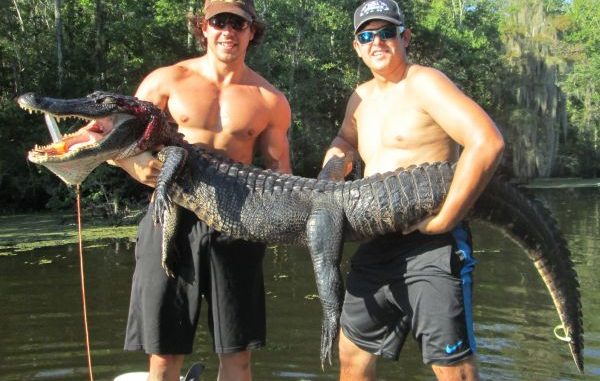
Opening weekend excitement on Elm Hall WMA
Unfortunately, my wife and I weren’t picked for the public land alligator lottery this year from the more than 5,000 people who applied.
But luckily for me, my buddy Andre was selected. So I made plans to join him during opening weekend, knowing better than to expect any of the craziness faked on those television shows.
That’s when the unexpected always seems to happen, and this weekend would prove to be no different.
On opening morning of alligator season, while I was out fishing with a friend, Andre and my buddy Cody had several gator lines set on Elm Hall WMA in Assumption Parish. One line was popped, one landed a nice 7-footer, and another had hooked a 10-plus-footer.
With a big ornery gator, getting the perfect head shot isn’t easy. And instead of firing a quick round, Andre had tried to work the gator on the line. But with one powerful death roll, the line popped and the behemoth got away.
I told him to pick me up from the boat launch first thing Sunday morning, and then I went to sleep dreaming about big gators.
They had been using 750-pound-test non-dipped twine, thinking it would be strong enough. But further inspection of the 7-footer’s line had revealed severe fraying.
The law says you need at least 500-pound-test, but I think 1,100-pound dipped rope is an even better bet. And more advice: use strong black rope when alligator hunting.
Another issue he had was tying the line to a solid piling with no give. Using a flexible tree limb or hammered-in, 10-foot-long, 2-inch PVC pipe angled slightly sideways will create a nice bowing effect that relieves pressure from powerful tugs.
Everyone is allowed to set two lines per tag, and is awarded up to three tags.
Any rotten bait works, but one-day-old chunks of beef melt or chicken quarters will tempt almost any gator into biting. (Just remember that after a couple of days, the chicken tends to fall apart and doesn’t stay on the hook very well.)
To keep from catching smaller gators, Andre set the rotting bait nearly 3 feet over the water.
I was amped about bagging a big gator, but the start was slow. All gator lines have to be tagged and flagged, and Andre had drawn his license numbers on a cut Coke can to make a waterproof tag.
But white string, bright flagging and a reflective tag apparently caught the attention of other fishermen: our first two lines were not only gatorless, they were missing hooks from someone cutting the lines.
Another line tied to a tree limb was also baitless, as mischievous raccoons will steal just as fast as dishonest boaters.
Frustration was setting in, but luckily we had one last line deep in the swamp.
The hook was down and a large cocodrie was tugging on the end. With that weak cord, it was only a matter of time before the line snapped, but we didn’t want to miss any more opportunities like that earlier 10-footer.
Boom! Andre made the first quick shot he could take using his 17 HMR the instant the big gator’s head popped up.
Unfortunately, an alligator with a tiny pecan-sized brain is a tough target, and his bullet missed the mark. The wounded gator started rolling and kicking furiously, then swam to the bottom.
Putting this large lizard in the boat quickly was our top priority, but pulling too hard on the string would risk another popped line.
I reached into the depths with the 7-foot gaff, and after nearly being pulled in myself, I yanked the thrashing gator to the surface once again.
Not taking any more chances with another misplaced bullet, we tossed the angry gator by the tail to boat the beast.
Without any fear, Cody jumped on the head and I jumped on the tail. Andre finished off the 8-footer right there in the center of the boat. (Whether the bullet would go through the hull was not as important as trying to take this monster down before someone lost a limb.)
Luckily, the bullet never exited the alligator’s head.
I came home with a scratch and punctured calf from the ordeal, and I ended up getting some antibiotics to treat an infection, but that kind of stuff is to be expected when you’re battling gators.
The next day, Labor Day, I took my wife fishing and Andre hooked another 8-foot alligator. He blasted it quickly, but was ready for an immediate gaffing just in case.
Andre sold his three gators for $30 per foot and netted about $630. A larger gator will get up to $40 per foot, and smaller ones go for less, according to their actual size.
Each gator tag costs $40, plus $25 for the license. And the meat can be purchased back from the dealer for about $3 per pound.
If you want to keep all the meat, you can clean your own gator but it must be skinned perfectly and refrigerated in salt.
Just remember, one error with the hide and your skin will be drastically devalued. It’s a tough process for beginners, but the tasty jowl meat and highly sought-after head fillets can be kept. These fillets are the very white strips located behind the gator’s eyes that taste amazing, much like the tenderloin of an animal.
Since telling my wife about our action-packed adventure, and hearing a story about a 600-pounder that was caught on the public land where we hunt, she can’t wait to try next year’s lottery again.
Laura is eager to shoot a big one to make a nice mount, but she said she’d leave the gator wrestling to me.


